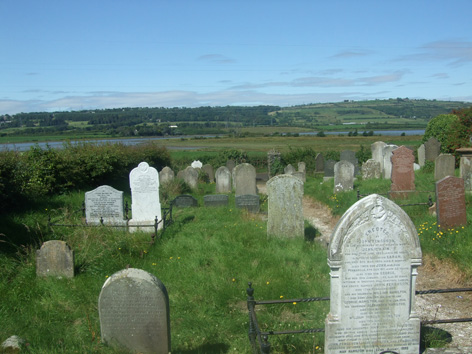
Ballykeel Church and Graveyard
Of historic interest nearby to the trail is Ballykeel Church and Graveyard. Situated on the Low Road, Islandmagee, approximately 2 miles north of Whitehead.
This graveyard takes its name from the townland in which it is situated, by the side of the Low Road that runs along the west side of Islandmagee, with good views looking out across Old Church Bay of Larne Lough towards Ballycarry and the Red Hall demesne. The graveyard is entered through a metal gate framed by two square stone pillars.
History of the site
Prior to the seventeenth century, Ransevyn was the name generally used for Islandmagee. In the papal taxation of 1306 mentions the Church of St John of Ransevyn – the church at this site in Ballykeel.
According to tradition, when Rev. Edward Brice first settled at Ballycarry in 1613 he preached alternately in Templecorran church and here. If true, then this church was used for a brief period as a Protestant place of worship.
The church
The ruined church is a simple rubble-built, rectangular structure, measuring 18m by 6.9m externally. The walls stand no more than 2m in height. The ruins are almost entirely covered in vegetation and there do not appear to be any surviving architectural details. The interior of the church has been used for burials.
In 1840 Ordnance Survey Memoir of Islandmagee noted several features which are not visible now. In the south wall there were two windows, one of which retained its circular head. In the north wall there were six blocked spaces which may have once been windows. There were two windows in the east gable, three feet apart and four feet from the ground. From the stonework, the compiler of the Ordnance Survey Memoir believed that the west gable was of more recent construction.
The churchyard
The most common names in this graveyard are Brennan (Branin/Brannan/Brenan/Brynan/Brynnan), Hill, and Nelson (Neilson/Nilson). The earliest date of death inscribed on a headstone is 1697. This commemorates Robert Kinkiaid [sic] who died on 22 January 1697 [new style 1698], aged 66. His small headstone features a coat of arms on its reverse side with the motto: ‘Who whilst alive will defend my life & honour to the end.’
Many of the memorials have maritime associations, relating to shipwrecks or people being lost at sea. For instance, Captain Daniel Ferguson’s son James, aged 18, was lost at sea by the foundering of the barque Colorado while on a voyage from Ayr to Demerara December 1887. Similarly, Robert Gray, aged 23, was lost at sea by the foundering of the ship Lord Downshire on her voyage from Iquique to Hamburg 14 July 1895.
Another headstone records three brothers from the Hoy family who died by drowning – John drowned at sea in 1884 aged 38, Ephraim drowned at W’head in 1881 aged 19, and William drowned at Troon in 1869 also aged 19.
Father and son met deaths at sea according the inscription on the Aiken headstone. Robert Aiken drowned at Swansea off the brig Anna Mary in 1880 aged 42. His son David died on board the SS Bangor on a voyage from Belfast to St John’s New Brunswick in 1905 aged 33 and was buried at sea.
There are other stones that point to the high levels of emigration that the parish has experienced. Places overseas, in generally warmer climes, that feature on headstones include Pensacola, Florida, Rio de Janeiro, Darwen [sic], Australia, and Accra, West Africa. The memorial to James Colville tells us that he was accidentally killed at Failford, Australia, NSW, in 1911 and interred at Ebenezar Cemetery.
A number of those commemorated dies as a result of the World Wars. Albert Stewart was ‘lost at sea through the torpedoing of the SS Bray Head’ on 14 March 1916 aged 16, while James Houston Heggen was ‘lost at sea by enemy action’ on 7 March 1941. William Hill died in Sydney, Australia, on 21 April 1919 aged 39 ‘from wounds received in action’.
Interestingly, there are no ministers of any denomination buried in this graveyard. One stone commemorates Thomas Hill, ‘formerly schoolmaster of Island Magee’, who died on 24 March 1821 aged 62, The inscription on his headstone concludes: ‘His kind attention to his scholars and benevolence to all is the cause of this stone being erected’.

